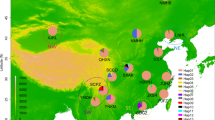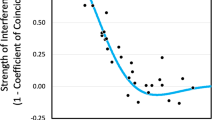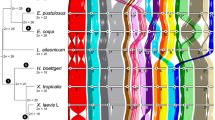Abstract
Several classes of models have been suggested to explain how natural selection can favour non-zero recombination. Directional and fluctuating selection, abiotic and biotic, and selection against harmful mutations seem to be the most plausible factors, but little has been done to test the problem experimentally. Here we show that long-term selection for positive or negative geotaxis in Drosophila melanogaster results in a dramatic increase in recombination rates in different genomic regions. The total increment in recombination for the genome portion considered is 78 cM for geo+ and 66 cM for geo−. Selection for negative geotaxis did not result in recombination changes in chromosome 2 whereas selection in the opposite direction caused nearly a four-fold increase in the b-cn segment and a significant, albeit not as high, increase in the adjacent regions, al-b and cn-vg. In chromosomes X and 3, a significant increase in recombination was found in both selected lines. In total, the increment in exchange frequency in chromosome X (y-cv-ct-v-car) was from 72.6 per cent (the control level) to 124.7 and 110.3 per cent geo− and geo+, respectively, whereas for the studied portion of chromosome 3 (ru-h-cu-sr-e) we obtained, correspondingly, 60.8, 76.4 and 73.8 per cent. Thus, in general, selection for geotaxis resulted in increased recombination frequencies regardless of the direction of selection. These results, taken together with other data, allow one to conclude that selection for fitness traits (e.g. for changed levels of quantitative traits, behavioural peculiarities or adaptation to adverse environmental conditions) may be a powerful factor causing rather rapid changes in the recombination system.
Similar content being viewed by others
Article PDF
References
Allard, R W. 1963. Evidence for genetic restriction of recombination in the lima bean. Genetics, 48, 1389–1395.
Bell, G, and Maynard Smith, J. 1987. Short-term selection for recombination among mutually antagonistic species. Nature, 328, 66–68.
Bergman, A, and Feldman, M W. 1990. More on selection for and against recombination. Theor Popul Biol, 38, 68–92.
Burt, A, and Bell, G. 1987. Mammalian chiasma frequencies as a test of two theories of recombination. Nature, 326, 803–805.
Charlesworth, B. 1976. Recombination modification in a fluctuating environment. Genetics, 83, 181–195.
Charlesworth, B. 1990. Mutation-selection balance and the evolutionary advantage of sex and recombination. Genet Res, 55, 199–221.
Charlesworth, B, and Charlesworth, D. 1985. Genetic variation in recombination in Drosophila. II. Genetic analysis of a high recombination stock. Heredity, 54, 85–98.
Chinnici, J P. 1971. Modification of recombination frequency in Drosophila. II. The polygene control of crossing over. Genetics, 69, 85–96.
Dewees, A A. 1975. Genetic modification of recombination rate in Tribolium castaneum. Genetics, 81, 537–552.
Felsenstein, J, and Yokoyama, S. 1976. The evolutionary advantage of recombination. Individual selection for recombination. Genetics, 83, 845–859.
Flexon, P B, and Rodell, C F. 1982. Genetic recombination and directional selection for DDT resistance in Drosophila melanogaster. Nature, 298, 672–675.
Gorlov, L, Schüler, L, Bunger, L, and Borodin, P. 1992. Chiasma frequency in strains of mice selected for litter size and for high body weight. Theor Appl Genet, 84, 640–642.
Gorodetsky, V P, Zhuchenko, A A, and Korol, A B. 1990. Efficiency of feedback selection for recombination in Drosophila. Genetika (USSR), 26, 1942–1952.
Hamilton, W D. 1980. Sex versus non-sex versus parasite. Oikos, 35, 282–290.
Harinarayama, G, and Murty, B R. 1971. Cytological regulation of recombination in Pennisetum and Brassica. Cytologia, 36, 345–348.
Hirsch, J. 1963. Behavior genetics and individuality understood. Science, 142, 1436–1442.
Hirsch, J. (ed.) 1967. Behavior-Genetic Analysis. McGraw-Hill, New York.
Kidwell, M G. 1972. Genetic change of recombination value in Drosophila melanogaster. 1. Artificial selection for high and low recombination and some properties of recombination modifying genes. Genetics, 70, 419–432.
Kondrashov, A S. 1988. Deleterious mutations and the evolution of sexual reproduction. Nature, 336, 435–440.
Korol, A, Preygel, I, and Preygel, S. 1990. Variability of Crossing-over in Higher Organisms. Shtiintsa, Kishinev (in Russian). (English version in press, Chapman & Hall.).
Landner, L. 1971. Genetic control of recombination in Neurospora crassa: correlated regulation in unlinked chromosome intervals. Heredity, 27, 385–392.
Maynard Smith, J. 1980. Selection for recombination in a polygenic model. Genet Res, 35, 269–277.
Maynard Smith, J. 1988. Selection for recombination in a polygenic model: the mechanism. Genet Res, 51, 59–63.
Michod, R E, and Levin, B R. (eds.). 1988. The Evolution of Sex: An Examination of Current Ideas. Sinauer, Sunderland.
Shaw, D D. 1972. Genetic and environmental components of chiasma control. II. The response to selection in Schistocerca. Chromosoma, 37, 297–308.
Stearns, S G. (ed.) 1987. The Evolution of Sex and its Consequences. Birkhauser, Basel.
Turner, J R G. 1979. Genetic control of recombination in the silkworm. Heredity, 43, 273–293.
Wolf, H G, Wohrmann, K, and Tomiuk, J. 1987. Experimental evidence for the adaptive value of sexual reproduction. Genetica, 72, 151–159.
Zhuchenko, A A, Korol, A B, Kovtyukh, L P, and Tabak, E P. 1983. Increased crossing-over frequency in a population experiencing selection for a resistance to temperature fluctuations. Doklady Acad Nauk USSR, 273, 721–725.
Zhuchenko, A A, Korol, A B, and Kovtyukh, L P. 1985. Change of crossing-over frequency in Drosophila during selection for resistance to temperature fluctuations. Genetica, 67, 73–78.
Author information
Authors and Affiliations
Rights and permissions
About this article
Cite this article
Korol, A., Iliadi, K. Increased recombination frequencies resulting from directional selection for geotaxis in Drosophila. Heredity 72, 64–68 (1994). https://doi.org/10.1038/hdy.1994.7
Received:
Issue date:
DOI: https://doi.org/10.1038/hdy.1994.7
Keywords
This article is cited by
-
Seasonal changes in recombination characteristics in a natural population of Drosophila melanogaster
Heredity (2021)
-
Y-chromosomes can constrain adaptive evolution via epistatic interactions with other chromosomes
BMC Evolutionary Biology (2018)
-
Phenotypic plasticity promotes recombination and gene clustering in periodic environments
Nature Communications (2017)
-
Effect of manipulating recombination rates on response to selection in livestock breeding programs
Genetics Selection Evolution (2016)
-
Experimental evolution of recombination and crossover interference in Drosophila caused by directional selection for stress-related traits
BMC Biology (2015)



